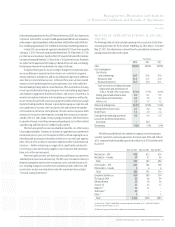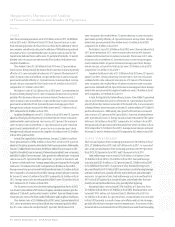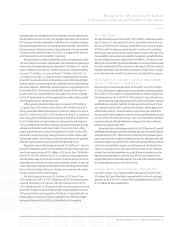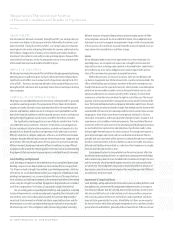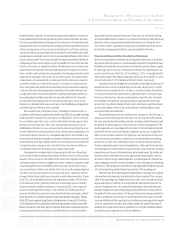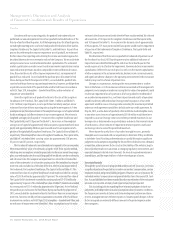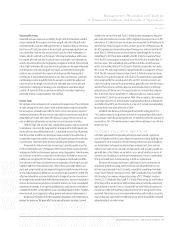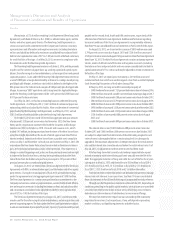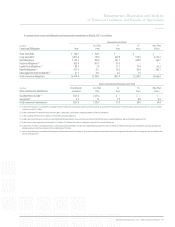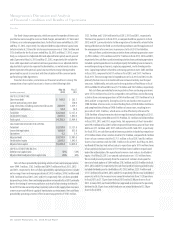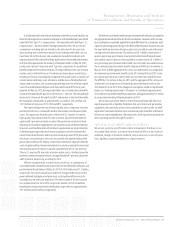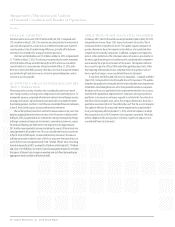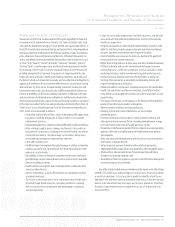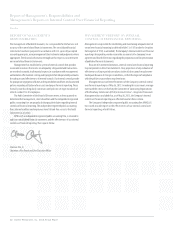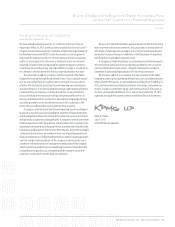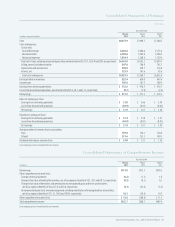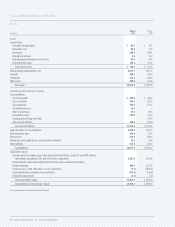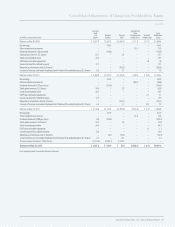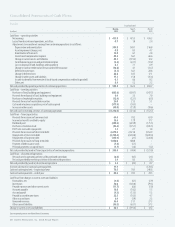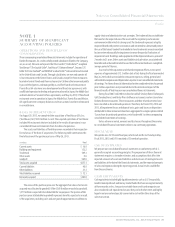Red Lobster 2013 Annual Report Download - page 33
Download and view the complete annual report
Please find page 33 of the 2013 Red Lobster annual report below. You can navigate through the pages in the report by either clicking on the pages listed below, or by using the keyword search tool below to find specific information within the annual report.
Management’s Discussion and Analysis
of Financial Condition and Results of Operations
Darden
Darden Restaurants, Inc. 2013 Annual Report 29
Our defined benefit and other postretirement benefit costs and liabilities are
determined using various actuarial assumptions and methodologies prescribed
underFASBASCTopic715,Compensation–RetirementBenefitsandTopic712,
Compensation–NonretirementPostemploymentBenefits.Weusecertain
assumptions including, but not limited to, the selection of a discount rate,
expected long-term rate of return on plan assets and expected health care cost
trend rates. We set the discount rate assumption annually for each plan at its
valuation date to reflect the yield of high-quality fixed-income debt instruments,
with lives that approximate the maturity of the plan benefits. At May 26, 2013,
our discount rate was 4.6 percent and 4.7 percent, respectively, for our defined
benefit and postretirement benefit plans. The expected long-term rate of return
on plan assets and health care cost trend rates are based upon several factors,
including our historical assumptions compared with actual results, an analysis of
current market conditions, asset allocations and the views of leading financial
advisers and economists. Our assumed expected long-term rate of return on plan
assets for our defined benefit plan was 9.0 percent for each of the fiscal years
reported. At May 26, 2013, the expected health care cost trend rate assumed for
our postretirement benefit plan for fiscal 2014 was 7.1 percent. The rate gradually
decreases to 5.0 percent through fiscal 2021 and remains at that level thereafter.
We made plan contributions of approximately $2.4 million, $22.2 million and
$12.9 million in fiscal years 2013, 2012 and 2011, respectively.
The expected long-term rate of return on plan assets component of our net
periodic benefit cost is calculated based on the market-related value of plan
assets. Our target asset fund allocation is 40 percent U.S. equities, 35 percent
high-quality, long-duration fixed-income securities, 20 percent international
equities and 5 percent real estate securities. We monitor our actual asset fund
allocation to ensure that it approximates our target allocation and believe that our
long-term asset fund allocation will continue to approximate our target allocation.
In developing our expected rate of return assumption, we have evaluated the
actual historical performance and long-term return projections of the plan assets,
which give consideration to the asset mix and the anticipated timing of the
pension plan outflows. We employ a total return investment approach whereby
a mix of equity and fixed income investments are used to maximize the long-term
return of plan assets for what we consider a prudent level of risk. Our historical
10-year, 15-year and 20-year rates of return on plan assets, calculated using the
geometric method average of returns, are approximately 9.5 percent, 8.0 percent
and 9.4 percent, respectively, as of May 26, 2013.
We have recognized net actuarial losses, net of tax, as a component of
accumulated other comprehensive income (loss) for the defined benefit plans and
postretirement benefit plan as of May 26, 2013 of $69.0 million and $1.3 million,
respectively. These net actuarial losses represent changes in the amount of the
projected benefit obligation and plan assets resulting from differences in the
assumptions used and actual experience. The amortization of the net actuarial
loss component of our fiscal 2014 net periodic benefit cost for the defined
benefit plans and postretirement benefit plan is expected to be approximately
$9.1 million and $0.0 million, respectively.
We believe our defined benefit and postretirement benefit plan assumptions
are appropriate based upon the factors discussed above. However, other assump-
tions could also be reasonably applied that could differ from the assumptions used.
A quarter-percentage point change in the defined benefit plans’ discount rate and
the expected long-term rate of return on plan assets would increase or decrease
earnings before income taxes by $0.6 million and $0.5 million, respectively. A
quarter-percentage point change in our postretirement benefit plan discount
rate would increase or decrease earnings before income taxes by $0.1 million. A
one-percentage point increase in the health care cost trend rates would increase
the accumulated postretirement benefit obligation (APBO) by $6.6 million at
May 26, 2013 and the aggregate of the service cost and interest cost components
of net periodic postretirement benefit cost by $0.5 million for fiscal 2013. A one-
percentage point decrease in the health care cost trend rates would decrease
the APBO by $5.2 million at May 26, 2013 and the aggregate of the service cost
and interest cost components of net periodic postretirement benefit cost by
$0.4 million for fiscal 2013. These changes in assumptions would not significantly
impact our funding requirements. We expect to contribute approximately
$0.4 million to our defined benefit pension plans and approximately $0.7 million
to our postretirement benefit plan during fiscal 2014.
We are not aware of any trends or events that would materially affect our
capital requirements or liquidity. We believe that our internal cash-generating
capabilities, the potential issuance of unsecured debt securities under our shelf
registration statement and short-term commercial paper should be sufficient to
finance our capital expenditures, debt maturities, stock repurchase program and
other operating activities through fiscal 2014.
OFF-BALANCE SHEET ARRANGEMENTS
We are not a party to any off-balance sheet arrangements that have, or are
reasonably likely to have, a current or future material effect on our financial
condition, changes in financial condition, sales or expenses, results of opera-
tions, liquidity, capital expenditures or capital resources.


